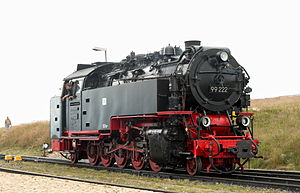
The Selke Valley Railway (Selketalbahn), Gernrode-Harzgerode Railway and the Anhalt Harz Railway were different names for the metre gauge railway in the Lower Harz, Germany, originally owned by the Gernrode-Harzgerode Railway Company.
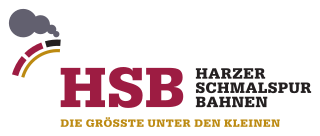
The Harz Narrow Gauge Railways is a railway company that operates a 1,000 mmmetre gauge network in the Harz mountains, in central Germany. The company was formed after the Second World War as a merger of two earlier companies. It owns about 140 kilometres of track, connecting the principal towns of Wernigerode, Nordhausen and Quedlinburg and several smaller settlements in the area. Much of the network is steeply graded and picturesque, but its most popular destination is the Brocken, the highest mountain in the region. The company runs a significant number of its trains with steam haulage, mostly employing 1950s vintage 2-10-2 tank locomotives, hauling traditional open-platform bogie carriages. The company is mainly owned by the various local authorities whose territories it serves.
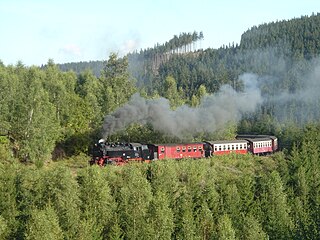
The Harz Railway or Trans-Harz Railway was formerly the main line of the Harz Narrow Gauge Railways and runs north to south right across the Harz Mountains from Wernigerode to Nordhausen. However, the tourist attraction of the Brocken, the highest mountain in the Harz, is so great that the Brocken Railway is effectively the main line today. The Trans-Harz Railway joins up with the Selke Valley Railway to Quedlinburg at Eisfelder Talmühle where all trains are organised to make good connections.

The DRB Class 50 is a German class of 2-10-0 locomotive, built from 1939 as a standard locomotive (Einheitsdampflokomotive) for hauling goods trains. It had one leading axle and five coupled axles and was one of the most successful designs produced for the Deutsche Reichsbahn.
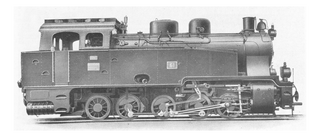
A Luttermöller axle is an unusual steam locomotive component. Steam locomotives with several axles or wheelsets connected to one another by coupling rods are not able to negotiate tight curves well. In order to assist such locomotives, the manager of the Orenstein & Koppel factory in Berlin, Dr. Luttermöller, built the axle system named after him.

The Einheitsdampflokomotiven, sometimes shortened to Einheitslokomotiven or Einheitsloks, were the standardized steam locomotives built in Germany after 1925 under the direction of the Deutsche Reichsbahn-Gesellschaft. Their manufacture made extensive use of standard design features and components.

The Class 99.32 engines were standard steam locomotives (Einheitsdampflokomotiven) in service with the Deutsche Reichsbahn in Germany. The three examples built are still working today on the Bäderbahn Molli between Bad Doberan and Kühlungsborn-West. A feature of the engines is the tapered driver's cab due to the restricted loading gauge of the upper section of the line. With a top speed of 50 km/h it is one of the fastest narrow gauge locomotive classes in the whole of Germany, however it cannot run at that speed on this particular route.

The German Class 99.73-76 engines were standard locomotives (Einheitslokomotiven) in service with the Deutsche Reichsbahn for Saxony's narrow gauge railways. Together with their follow-on class, the DR Class 99.77-79, they were the most powerful narrow gauge locomotives in Germany for the 750 mm track gauge.

German Kleinlokomotiven like the DRG Kö II were developed as locomotives with a low weight and driving power for light shunting duties. There were two classes, based on engine power. The Class II were engines which developed more than 40 HP.
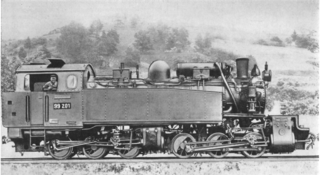
The Bavarian Class Gts 2x3/3 was a former narrow gauge, German Army, military railway, steam locomotive that was in service on the narrow gauge line from Eichstätt to Kinding.
The DRG locomotive classification system was developed by the German Imperial Railway Company or Deutsche Reichsbahn-Gesellschaft (DRG), which was formed in 1924 following the merger of the German state railways (Länderbahnen) in 1920. A common classification and numbering scheme was needed in order to organise effectively the four hundred or so different steam locomotive classes taken over from the state railways, as well as new locomotives. This process lasted until 1926. Only then was the final renumbering plan fixed.

The DR locomotive classification scheme in East Germany in the initial post-war period used the DRG system, consisting of a class number (Baureihennummer) followed by a serial number (Ordnungsnummer). With the introduction of computerised (EDP) numbers in 1970 as part of the UIC framework, the system was fundamentally changed for the first time.

The engines of DR Class 99.23 are metre gauge tank locomotives, that were procured by the Deutsche Reichsbahn (DR) in East Germany from 1954 to 1956. When they entered service they had operating numbers 99 231–99 247. Today they are numbered 99 7231–99 7247.

The steam locomotives of DR Class 99.77–79 were ordered by the Deutsche Reichsbahn in East Germany after the Second World War. They were narrow gauge locomotives with a 750 mm rail gauge and were built for the narrow gauge lines in Saxony. The locomotives were largely identical to the DRG Class 99.73–76 standard locomotives (Einheitslokomotiven) built in the 1930s. To differentiate them from their predecessors they were described as Neubaulokomotiven or newly designed engines.

The Saxon Class V K were German 0-8-0T narrow gauge steam locomotives operated by the Royal Saxon State Railways which had been primarily intended for the Müglitztalbahn. In 1925 the Deutsche Reichsbahn incorporated arranged these locomotives as DRG Class 99.61.
Steam traction was the predominant form of motive power used by the Deutsche Reichsbahn on its narrow-gauge railways. For certain duties diesel locomotives were also used, albeit these were usually second-hand or rebuilt engines.

The Nordhausen-Wernigerode Railway Company incorporated twelve Mallet locomotives into its fleet as Numbers 11 to 22. In 1950 the remaining locomotives were renumbered as Class 99.590 by the Deutsche Reichsbahn.

The NWE No. 21II, later DR 99 6001 is a narrow gauge steam locomotive that was built in 1939 for a track gauge of one metre and is still on duty with the Harz Narrow Gauge Railways (HSB) today.

The PKP class Lyd1 is a narrow gauge diesel locomotive class, covering two similar models built in Poland: WLs150 built by Fablok, and its development WLs180 (803D) manufactured by Zastal. It was used by Polish State Railways (PKP) on the narrow gauge railways in Poland, and on industrial railways.
